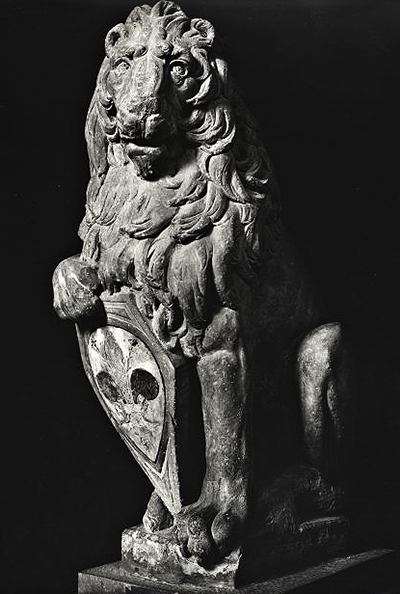The origin of the term Marzocco is obscure. However, it may have come from Mark the evangelist whose emblem is a lion or from Mars (Marte), the pagan protector of Florence.
Donatello sculpted his Marzocco out of a grey sandstone that was brought from Tuscany and was referred to as "pietra serena." In this sculpture, Donatello has his lion seated even as it holds the Florentine coat-of-arms. That stated, the Marzocco is an incredibly essential work as it's the creative synthesis of the symbols of Florence: the lion and the red lily.
Donatello would later be referred to as the most critical sculptor to revive classical sculpture from its tomb in ancient times. Therefore his style became a revitalized fashion that departed from the Gothic length's flat iconography.
He broke ground through introducing a new appreciation of artistic taste and beauty in keeping with the time's blossoming move closer to humanism. It was a movement that highlighted a departure from medieval scholasticism and favoured deep immersion into the arts.
Sculpture Techniques
This resulted in artwork like Marzocco that was not centred entirely on the earthly realm of religion. But it explored man's abode inside the natural world. Donatello's works brought about an interest in architecture, arithmetic, and sciences that were evolving at the time in Florence. The method used in creating a new type of moulding was the one point angle. The method was applied in architectural works and a uniqueness that brought about structural correctness for his sculptures like Marzocco.
Donatello also applied Roman and historical Greek lost-wax casting to mould a type of hollow bronze. He diversified his artistic prowess by giving the human body preference, unlike the spirit that was the order of the day. His works also echoed the merger of classical cultures and beauty.
A good example of such works is in David's bodily shape, which is a flexible frame that was cast in a curvy posture. The irregular balance of David's position (c.1440-43) has one hip projecting forward and has his weight moved to one leg. It brought forth a robust impulse to lovers of art. It portrayed a traditional Renaissance skill that is called contrapposto.
Donatello incorporated his traditional style and artistic expertise and made Marzocco look real. The eyes of the lion look wise and delighted. The top torso of the lion is prolonged to spotlight a luxurious mane and its posture projects the Marzocco as human. The Marzocco's head is pleasing since it has attributes of a living being.
The Theme of his Artwork
The figure became a crucial point of Donatello's mastery. He was, in reality, the first to introduce the nude sculpture. With the addition of practical proportion, emotionality, and expression to his topics like Marzocco, Donatello created works that conveyed a truth over the idealized imagery of earlier times.
Only a genius like Donatello would be able to join two symbols of the city of Florence with a masterpiece like Marzocco. The lion is in a quiet stance, no longer competitive: his front right paw is cradling the red lily. It definitely is a warning for any enemy of Florence. The lion (or the God Mars) is protecting this town. Therefore Donatello's Marzocco represents Florence and its records in an enticing manner.
This early work by Donatello were liked very much due to their exceptional qualities and so they became an image of the Florentine Renaissance in Art.
Materials
Donatello's ingenuity and versatility laid a foundation for many upcoming sculptors who desired to discover new prospects in materiality.
In his artistic experiment and delivery, Donatello used different mediums like wax, bronze, stone, stucco, bronze, wood and clay. Among the modern artists, Donatello was the first to exemplify the art of sculpture.
Artists Influenced by Donatello
Scholars of art are convinced that Michelangelo was encouraged by his mentor Donatello. But these two never met. Michelangelo is recounted to have said that he had never seen honest figures like those of Donatello.
Michelangelo became a student of the great Lorenzo de' Medici from 1490 to 1492. Lorenzo had also been influenced by Donatello. And later, Michelangelo became Bertoldo di Giovanni's student of art. Bertoldo was a peer of Donatella and learned a lot from Donatella. No wonder Donatella was famed as the finest and greatest sculptor from Florence in the 15th-century. Therefore, when Michelangelo became Bertoldo di Giovanni' student, Bertoldo exposed Michelangelo to sculptural procedures and works of the great Donatello.
Lorenzo de' Medici had the vision to revive the artwork of sculpture of the ancient Greeks and Romans. He had a collection of historic art that Michelangelo studied thoroughly. Classical art offered an inspiration and a standard of excellence and Michelangelo strived to surpass it. But Michelangelo became enthusiastic about the paintings of Donatello like Marzocco.
A great example of Donatella on Michelangelo's work is vividly shown in Moses by Michelangelo that is dated 1408. It is a well-thought-out masterpiece of the pronounced revival of art (Renaissance). The sitting position of Donatella's masterpiece called John (the Baptist) offers a great comparison. John holds a book with the left hand while Michelangelo has his sculpture tagged Moses.
Michelangelo uses folds of cloth which aid in creating a powerful and sturdy figure of Moses. Therefore Moses' presence is highly magnified using this technique. John has his flowing beard well-choreographed by Donatella. He stares instantly out at us which Michelangelo copied to show the visual effect of his Moses when he turned the head of Moses to his left. Marzocco tells of a photographic effect and a thoughtful idea that was bequeathed to us by Donatella in his creative endeavour.




